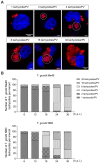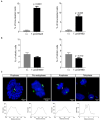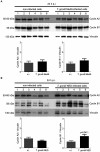Toxoplasma gondii Me49 and NED strains arrest host cell cycle progression and alter chromosome segregation in a strain-independent manner
- PMID: 38450167
- PMCID: PMC10915083
- DOI: 10.3389/fmicb.2024.1336267
Toxoplasma gondii Me49 and NED strains arrest host cell cycle progression and alter chromosome segregation in a strain-independent manner
Abstract
Toxoplasma gondii is an obligate intracellular parasite that modulates a broad range of host cell functions to guarantee its intracellular development and replication. T. gondii includes three classical clonal lineages exhibiting different degrees of virulence. Regarding the genetic diversity of T. gondii circulating in Europe, type II strains and, to a lesser extent, type III strains are the dominant populations, both in humans and animals. Infections with the type I strain led to widespread parasite dissemination and death in mice, while type III is considered avirulent. Previously, we demonstrated that primary endothelial cells infected with the T. gondii RH strain (haplotype I) were arrested in the G2/M-phase transition, triggering cytokinesis failure and chromosome missegregation. Since T. gondii haplotypes differ in their virulence, we here studied whether T. gondii-driven host cell cycle perturbation is strain-dependent. Primary endothelial cells were infected with T. gondii Me49 (type II strain) or NED (type III strain), and their growth kinetics were compared up to cell lysis (6-30 h p. i.). In this study, only slight differences in the onset of full proliferation were observed, and developmental data in principle matched those of the RH strain. FACS-based DNA quantification to estimate cell proportions experiencing different cell cycle phases (G0/1-, S-, and G2/M-phase) revealed that Me49 and NED strains both arrested the host cell cycle in the S-phase. Cyclins A2 and B1 as key molecules of S- and M-phase were not changed by Me49 infection, while NED infection induced cyclin B1 upregulation. To analyze parasite-driven alterations during mitosis, we demonstrated that both Me49 and NED infections led to impaired host cellular chromosome segregation and irregular centriole overduplication. Moreover, in line with the RH strain, both strains boosted the proportion of binucleated cells within infected endothelial cell layers, thereby indicating enhanced cytokinesis failure. Taken together, we demonstrate that all parasite-driven host cell cycle arrest, chromosome missegregation, and binucleated phenotypes are T. gondii-specific but strain independent.
Keywords: Me49 strain; NED strain; Toxoplasma gondii; cell cycle arrest; cell cycle dysregulation; haplotypes.
Copyright © 2024 Rojas-Barón, Hermosilla, Taubert and Velásquez.
Conflict of interest statement
The authors declare that the research was conducted in the absence of any commercial or financial relationships that could be construed as a potential conflict of interest.
Figures




Similar articles
-
Toxoplasma gondii infection-induced host cellular DNA damage is strain-dependent and leads to the activation of the ATM-dependent homologous recombination pathway.Front Cell Infect Microbiol. 2024 Mar 8;14:1374659. doi: 10.3389/fcimb.2024.1374659. eCollection 2024. Front Cell Infect Microbiol. 2024. PMID: 38524184 Free PMC article.
-
Toxoplasma gondii modulates the host cell cycle, chromosome segregation, and cytokinesis irrespective of cell type or species origin.Parasit Vectors. 2024 Apr 5;17(1):180. doi: 10.1186/s13071-024-06244-2. Parasit Vectors. 2024. PMID: 38581071 Free PMC article.
-
Toxoplasma gondii-induced host cellular cell cycle dysregulation is linked to chromosome missegregation and cytokinesis failure in primary endothelial host cells.Sci Rep. 2019 Aug 29;9(1):12496. doi: 10.1038/s41598-019-48961-0. Sci Rep. 2019. PMID: 31467333 Free PMC article.
-
Apoptosis and S phase of the cell cycle in BeWo trophoblastic and HeLa cells are differentially modulated by Toxoplasma gondii strain types.Placenta. 2009 Sep;30(9):785-91. doi: 10.1016/j.placenta.2009.07.002. Epub 2009 Jul 30. Placenta. 2009. PMID: 19643475
-
Besnoitia besnoiti-driven endothelial host cell cycle alteration.Parasitol Res. 2020 Aug;119(8):2563-2577. doi: 10.1007/s00436-020-06744-x. Epub 2020 Jun 17. Parasitol Res. 2020. PMID: 32548739 Free PMC article.
Cited by
-
Naringin and temozolomide combination suppressed the growth of glioblastoma cells by promoting cell apoptosis: network pharmacology, in-vitro assays and metabolomics based study.Front Pharmacol. 2024 Jul 30;15:1431085. doi: 10.3389/fphar.2024.1431085. eCollection 2024. Front Pharmacol. 2024. PMID: 39148542 Free PMC article.
-
Toxoplasma gondii infection induces early host cell cycle arrest and DNA damage in primary human host cells by a MYR1-dependent mechanism.Commun Biol. 2024 Dec 16;7(1):1637. doi: 10.1038/s42003-024-07374-0. Commun Biol. 2024. PMID: 39681694 Free PMC article.
-
Cellular Senescence Contributes to Colonic Barrier Integrity Impairment Induced by Toxoplasma gondii Infection.Inflammation. 2025 Aug;48(4):2600-2612. doi: 10.1007/s10753-024-02213-0. Epub 2025 Jan 18. Inflammation. 2025. PMID: 39827329 Free PMC article.
References
-
- Alberts B., Johnson A., Lewis J., Raff M., Roberts K., Walter P. (2007). “The cell cycle” in Molecular biology of the cell 5th edition, Garland Science, (New York: W.W. Norton & Company; ).
LinkOut - more resources
Full Text Sources

